A common classification of the Lepidoptera involves their differentiation into butterflies and moths. Butterflies are a natural monophyletic group, often given the suborder Rhopalocera, which includes Papilionoidea, Hesperiidae (skippers), and Hedylidae. In this taxonomic scheme, moths belong to the suborder Heterocera. Other taxonomic schemes have been proposed, the most common putting the butterflies into the suborder Ditrysia and then the "superfamily" Papilionoidea and ignoring a classification for moths.

The silver-washed fritillary is a common and variable butterfly found over much of the Palearctic realm – Algeria, Europe and across the Palearctic to Japan.

Bhutanitis lidderdalii, the Bhutan glory, is a species of swallowtail butterfly, which is found in Bhutan, parts of northeastern India and of Southeast Asia. A spectacular insect much sought after by collectors, the species epithet is after Dr R. Lidderdale, from whose collection the butterfly was first described by William Stephen Atkinson in 1873. Listed under CITES Appendix II, the status of the butterfly has been recorded as rare by some authorities but as being of least concern in 2019 by the Red Book of the IUCN.
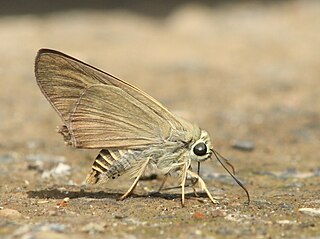
Badamia exclamationis, commonly known as the brown awl or narrow-winged awl, is a butterfly belonging to the family Hesperiidae. It is found in south and southeast Asia, Australia, and Oceania.

Idea leuconoe, also known as the paper kite butterfly, rice paper butterfly, large tree nymph, is a butterfly known especially for its presence in butterfly houses and live butterfly expositions. It has a wingspan of 12 to 14 cm. The paper kite is of Southeast Asian origin, but can also be found in Southern Taiwan and the Ryukyu Islands.

Papilio nephelus is a species of swallowtail butterfly belonging to the family Papilionidae. Subspecies include P. n. chaon, the yellow Helen, and P. n. sunatus, the black and white Helen.

Athyma selenophora, the staff sergeant, is a species of nymphalid butterfly found in tropical and subtropical Asia.

Parantica nilgiriensis, the Nilgiri tiger, is a butterfly found in the Western Ghats of India south of the Konkan. It belongs to the danaid group of the brush-footed butterflies family.

Idea malabarica, the Malabar tree nymph, is a large butterfly found in peninsular India. that belongs to the danaid group of the family Nymphalidae. It is found in forest clearings and above the forest canopy.
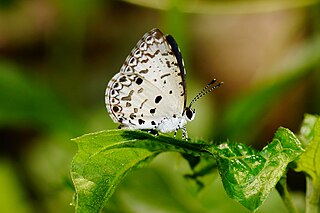
Megisba malaya, the Malayan, is a small butterfly found in South Asia and Southeast Asia. It belongs to the family of gossamer-winged butterflies (Lycaenidae). The species was first described by Thomas Horsfield in 1928.

Hypolimnas misippus, the Danaid eggfly, mimic, or diadem, is a widespread species of nymphalid butterfly. It is well known for polymorphism and mimicry. Males are blackish with distinctive white spots that are fringed in blue. Females are in multiple forms that include male-like forms while others closely resemble the toxic butterflies Danaus chrysippus and Danaus plexippus.

Ideopsis vulgaris, the blue glassy tiger, is a butterfly that belongs to the crows and tigers, that is, the danaid group of the brush-footed butterflies family.

Ideopsis is a genus of nymphalid butterflies in the subfamily Danainae found in South-east Asia.

The Ceylon tree nymph is a species of nymphalid butterfly in the subfamily Danainae. It is endemic to Sri Lanka. First described by John Westwood in 1848, the Ceylon tree nymph can be found in both wet and dry zones of Sri Lanka. It is the largest member of the family Danaidae in that country. It is listed as a near threatened species in the IUCN Red List.
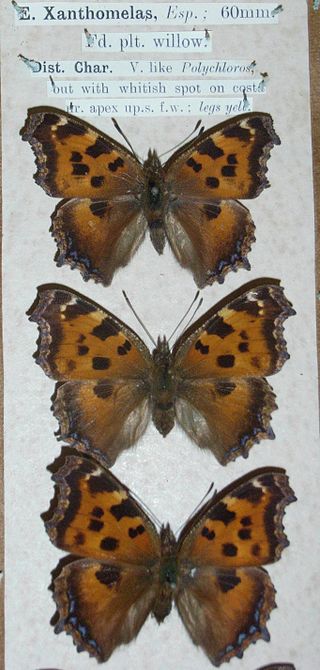
Nymphalis xanthomelas, the scarce tortoiseshell, is a species of nymphalid butterfly found in eastern Europe and Asia. This butterfly is also referred as yellow-legged tortoiseshell or large tortoiseshell.

Sevenia boisduvali, the Boisduval's tree nymph, is a butterfly in the family Nymphalidae. There are four subspecies; all native to Africa.
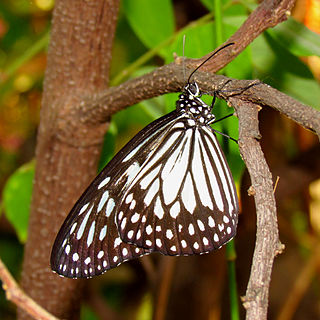
Ideopsis juventa, the wood nymph, gray glassy tiger or grey glassy tiger, is a species of nymphalid butterfly in the Danainae subfamily. It is found in Southeast Asia.
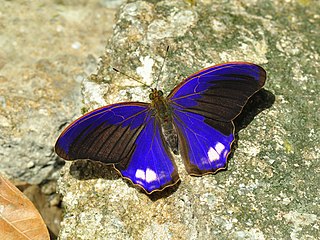
Terinos is a genus of Nymphalid butterflies. They are found from Burma, through South-East Asia, to New Guinea.

Mimoides pausanias, the Pausanias swallowtail or bluish mimic-swallowtail, is a species of butterfly in the family Papilionidae.
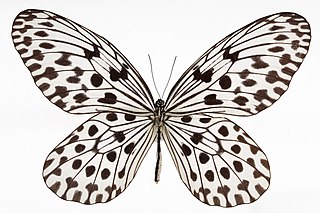
Idea hypermnestra is a large butterfly that belongs to the danaid group of the family Nymphalidae. It was described by John Obadiah Westwood in 1848. It is found in the Indomalayan realm.




















